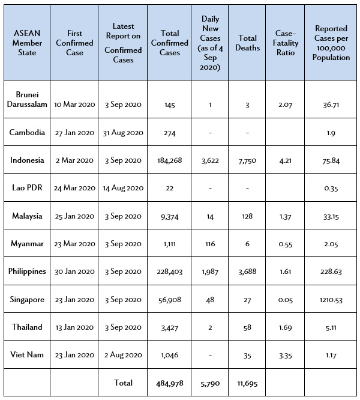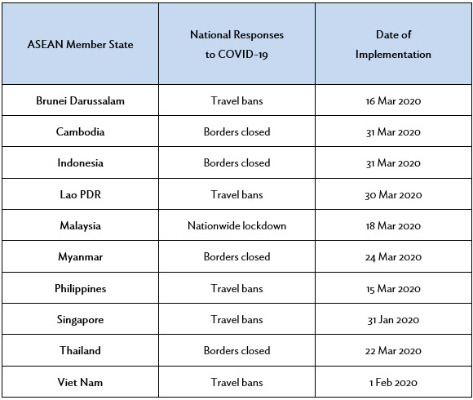The Impacts Of COVID-19 On Financial Stability And Regional Financial Safety Nets In ASEAN
By Pitchaya Sirivunnabood and Santi Setiawati

The Association of Southeast Asian Nations (ASEAN) is making strong efforts to maintain financial stability amid the coronavirus disease (COVID-19) pandemic, mostly through national financial emergency measures for each member state. As a region, ASEAN has not yet formed a regional financial safety net to deal with a crisis like COVID-19.
COVID-19 in ASEAN
Like other regions affected by the outbreak of COVID-19, ASEAN member states (AMS) are seeing a large number of confirmed cases. According to data from the World Health Organization (WHO), daily new cases in some AMS have been rising, although the pace is decelerating (Table 1). The spread of COVID-19 across the region has caused economic downturns and even stopped some economic activities, resulting in negative spillover effects on the region’s financial stability. International reserves may be deteriorating, and external debt could rise as government spending shoots up due to the launch of large stimulus packages.
Table 1: Trends in Cases of COVID-19 in ASEAN Member States

Lao
PDR = Lao People’s Democratic Republic.
Source:
Association of Southeast Asian Nations estimates.
AMS promptly responded to COVID-19 with several emergency measurements once the first confirmed cases were detected (Table 2). Lockdowns, community quarantines, and travel bans have been the primary policies. Thailand, Viet Nam, and Malaysia were the first three countries to impose travel restrictions to and from the People’s Republic of China (PRC), Europe, and North America.
Table 2: National Responses to COVID-19 in ASEAN Member States

Lao
PDR = Lao People’s Democratic Republic.
Source:
Authors, based on estimates by the Organisation for Economic
Co-operation and Development.
Although the main intention of these responses is to control the spread of COVID-19 and prevent citizens from becoming infected, economic consequences for the private and public sectors are inevitable. Lockdowns and other restrictions are harming business sectors, particularly vulnerable groups like small and medium-sized enterprises (SMEs) and informal workers. In response to these impacts, SMEs are reducing their production or services, and this is causing income losses, higher unemployment, and liquidity shortages. Surveys carried out by the Organisation for Economic Co-operation and Development (OECD) on the impacts of COVID-19 on 41 SMEs worldwide have shown that more than half of SMEs face severe revenue losses. Thailand, for example, reported that 90% of its firms expect extreme revenue losses (OECD 2020). Tourism and transportation are the two sectors that have been hit the hardest by COVID-19 lockdowns.
AMS have launched fiscal stimulus packages to fight the pandemic. These, in turn, have caused an increase in government debt. These stimulus packages could amplify the impacts of a rise in borrowing costs, such as through elevated debt (Lao PDR, Malaysia, and Viet Nam), sizable fiscal deficits (Lao PDR and Viet Nam), greater reliance on volatile capital flows (Cambodia and Indonesia), and considerable foreign holdings of domestic debt (Indonesia, Malaysia, and Thailand). Although the composition and the stimulus amounts vary by country, they are mostly given to support vulnerable SMEs and households.
AMS have also implemented expansionary monetary policy to create liquidity in the system, for example, by decreasing the required reserve ratio, creating funds for lending to firms, cutting benchmark interest rates, implementing temporary suspensions of interest repayments, and relaxing the payment conditions for loans related to COVID-19. Nonetheless, spillover effects on systemically important financial institutions are unavoidable, and there are signs of phenomena such as runs on banks (holding cash and other safe-haven instruments privately), collapse of the currency exchange rate, and risks for banks’ liquidity, markets, and credit, which all threaten financial stability. As a result, financial safety nets are necessary not only at the national level but also at the regional level to ensure and maintain financial stability in both the foreign exchange and capital markets and to prevent financial crises that could occur from such unprecedented causes.
ASEAN’s regional financial safety net
Unlike other financial crises, which are rooted in several threads of industrial, financial, and monetary phenomena, both pandemics and natural disasters are unpredictable. Some believe that a pandemic is similar to a natural disaster as it can further result in an economic and financial crisis. However, what differentiates one type of crisis from the other is the severity and duration of the shock. A natural disaster is a shock localized in a particular region or in specific sectors, like tourism. A pandemic, however, is a widespread shock with a prolonged duration that is systemic in nature and can cause scaled impacts, possibly leading to a financial crisis. The COVID-19 situation is systemic and unprecedented at the global and regional levels, as the shock hits and contractions happen in all economies simultaneously.
To ensure financial stability in the region, ASEAN has taken initiatives under the ASEAN Plus Three (ASEAN+3) financial cooperation. The first mechanism was developed in response to the Asian Financial Crisis of 1997–1998. The Chiang Mai Initiative Multilateralism (CMIM) has been developed since then under the ASEAN+3 initiative as a network of bilateral swap arrangements, amounting to $120 billion in March 2010. The development of the implementation and surveillance process is being progressed to improve the effectiveness and promptness of the mechanism in response to potential financial crises. The ASEAN Disaster Risk Financing and Insurance (ADRFI), on the other hand, is being developed to strengthen regional financial resilience in the context of climate change as natural catastrophes strike. The comprehensive framework is being designed to equip AMS with risk management and risk transfer capabilities. This framework will enable them to overcome the financial burden caused by disasters. The activities include both ex-ante and ex-post arrangements.
In response to the impact of COVID-19, ASEAN has yet to develop a regional mechanism for the pandemic crisis or equivalent ones. The policy gap in both the CMIM and ADRFI initiatives for dealing with transnational disease outbreaks is the gap in technical and financial capacity and cooperation in the public health sector among the AMS. This includes funding to hospitals and medical clinics, health care training for emerging states, and the stockpiling of medicines, alcohol, surgical masks, vaccines, and other emergency equipment to quickly tackle the spread of a transnational disease. At the global and regional levels, international financial institutions have also supported the countries affected by the COVID-19 outbreak. The International Monetary Fund uses the Catastrophe Containment and Relief Trust to support its member countries, while multilateral development banks like the Asian Development Bank (ADB) have supported countries in the region, e.g., Thailand, the Philippines, and Indonesia, through grants and loan approvals (Figure 1). Although this financial support provides a significant increase in liquidity, this might not be enough to respond to a systemic financial crisis in the region.
Figure 1: Countries Receiving COVID-19 Financial Assistance from the Asian Development Bank

Source: Author, based on data from the Asian Development Bank website.
Proper and timely policy options can reduce
the economic impacts of the pandemic with the support of
regional cooperation. We propose three policy
recommendations for consideration as policy options. First,
the establishment of an ASEAN task force on pandemics will
facilitate the coordination and alignment of policy
responses across AMS. A regional framework for policy
response can create public trust and promote transparency.
Second, the building-up of an ASEAN pandemic network
consisting of hospitals, healthcare workers, pharmaceutical
companies, and research institutions is needed to share
information and knowledge on healthcare resources for
mitigating pandemic-related shocks and preparing financing
schemes. Third, regional financial safety nets must be
strengthened through the contribution of funding capacity
and by broadening their role to manage the financial effects
of the COVID-19
outbreak.
_____
References:
Association
of Southeast Asian Nations (ASEAN). 2020. Regional
Cooperation in Finance. (accessed 20 August
2020).
ASEAN. 2020. Economic
Impact on COVID-19 Outbreak on ASEAN.
ASEAN.
2020. Enterprise
Policy Response to COVID-19 in ASEAN.
ASEAN.
2020.
Risk Assessment for International Dissemination of COVID-19
to the ASEAN Region.
Center for Strategic and
International Studies. Southeast
Asia COVID-19 Tracker. (accessed 20 August
2020).
International Monetary Fund (IMF). 2020. Policy
Responses to COVID-19. (accessed 17 August
2020).
Organisation for Economic Co-operation and
Development (OECD). 2020. COVID-19
Crisis Responses in ASEAN Member States. (accessed 4
August 2020).
The post The impacts of COVID-19 on financial stability and regional financial safety nets in ASEAN appeared first on Asia Pathways.


 Professional Footballers Australia PFA: PFA Partners With UK’s ‘The Great Save’ To Reduce Football Kit Waste
Professional Footballers Australia PFA: PFA Partners With UK’s ‘The Great Save’ To Reduce Football Kit Waste Doctors Without Borders: Israeli Authorities Must Stop Collective Punishment Of Palestinians And Use Of Aid As A Tool Of War
Doctors Without Borders: Israeli Authorities Must Stop Collective Punishment Of Palestinians And Use Of Aid As A Tool Of War RNZ: New Child Sex Offence Charges For Disgraced Businessman Ron Brierley
RNZ: New Child Sex Offence Charges For Disgraced Businessman Ron Brierley The Human Dignity Trust: End Criminalisation Of Same-Sex Intimacy Across The Commonwealth
The Human Dignity Trust: End Criminalisation Of Same-Sex Intimacy Across The Commonwealth UN News: Explainer - The Commission On The Status Of Women And Why It Matters
UN News: Explainer - The Commission On The Status Of Women And Why It Matters 350.org: Pacific Island Communities Prepare For Australia Elections
350.org: Pacific Island Communities Prepare For Australia Elections